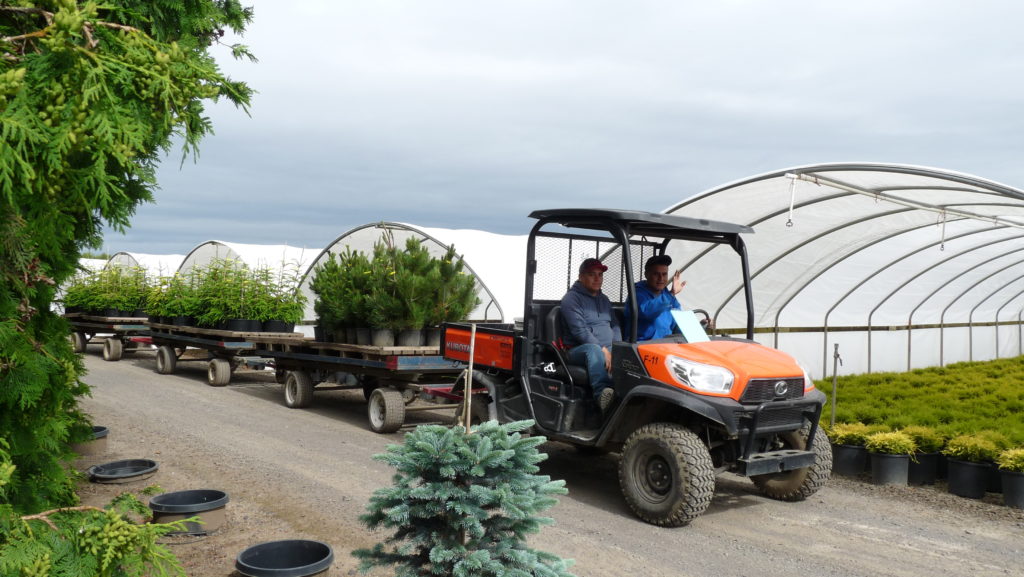Growers on both coasts have always worked on a year-round basis, while their Midwest and Rocky Mountain colleagues had more seasonal fluctuations with labor. No doubt, the spring season remains busiest for all, but over the past decade or two, the slower seasons have been getting busier. A long period of down time is becoming a distant memory.
Container production, the pervasive I-want-it-now culture, and increased forecasting data are three major reasons for the loss of off seasons in the green industry, according to Barry Gregory at Kraemer’s Nursery in Mount Angel, Ore.

“To me, the industry has changed quite a bit. I do think 15 to 20 years ago there was so much more production of bare root and balled and burlapped trees and shrubs. Thirty years ago, it was a spring game. That’s what you got for the year,” said Gregory, who is Sales and Marketing Vice President for the 850-acre (or 650-acre?) wholesale grower south of Portland.
“Now there is so much container-grown production. Because we can ship plants any time of year, work never stops. We got out of the B&B business right around the time of the big recession in 2010. Now, 100% of our production is container grown or container established before we ship it; 100% of it is in pots,” he explained.
Container plants delivered year-round satisfy consumers who are getting used to instant gratification. Our modern, online society has become more of ‘I want it now and I’m going to get it now.’

Containers provide not only a way to harvest plants year-round, but offer a patio-ready product whether annuals or perennials. You can pick up your desired plant, take it home, put it on your deck, and voila—instant yard beautification.
“Consumer habits have changed a lot. A lot of that is driven by the inventory and what’s available to them in the stores, compared to 20 years ago. After spring, if it was gone, it was gone. Now it can be replenished in little more than 24 hours. In three to four days, you can have a whole new crop in your store,” he said.
With customers developing a less predictable, insatiable demand for plants, growers and garden centers have to plan their inventory more carefully. While growing or ordering too much can be costly, resulting in wasted plants, not growing or ordering enough can also be bad for the bottom-line.

“We spend a lot of time on analyzing and forecasting. It’s by far the most important thing we do. If we do that, then we are going to have the right mix of inventory and hopefully not run out until we should,” he said, but added, “If you don’t run out of plants at some point, you’re probably not going to make a lot of money because you’re probably throwing some away. Running out at the right time is pretty important.”
Precise inventory analysis is another task that is keeping people at work more during traditional off seasons. With so much more information at our fingertips, owners, managers and sometimes sales people spend much of the offseason analyzing and studying the numbers and trends.

“The amount of information available to us grows more and more every year. Computers can do a lot for you. I was a lot more intuitive 20 years ago. I sat around and said this is what is left, so maybe we should not grow so many of those and we should grow more of these. I did it more by my gut, but now it is more data driven,” he admitted.
Gregory doesn’t think the seasonal pace of business is going to change back to include off seasons again. Instead, he expects the green industry to require more and more year-round labor.
“We go from starting with spring being extremely busy, shipping lots and lots of product, and that goes on for two to three months. As soon as we finish that, we start taking all the data we have collected and all the POS (point of sale) information from customers. We find out what worked and what didn’t work, look for trends, take that information, and turn it into a forecast. Then the forecast turns into a new production plan to tell us what to grow. From there, we start planting, and making sure we have all the labels and necessary supplies. All of a sudden, we find ourselves at spring again,” he lamented with a laugh.










